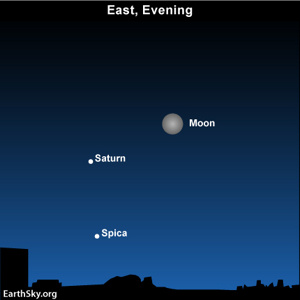Courtesy of EarthSky
A Clear Voice for Science
Visit EarthSky at
www.EarthSky.org

 Today – March 19 – features the closest full moon of 2011. Some are calling it a supermoon. As a result, you might look for higher-than-usual tides along the ocean coastlines throughout the world.
Today – March 19 – features the closest full moon of 2011. Some are calling it a supermoon. As a result, you might look for higher-than-usual tides along the ocean coastlines throughout the world.
What is true – and false – about the March 19 supermoon
What’s more, the bright point of light near tonight’s moon is the planet Saturn, the sixth planet outward from the sun.
Because the full moon shines opposite the sun in our sky, you will see the moon beaming all night tonight from dusk until dawn. This extra-close full moon is likely to usher in large tides along the ocean shorelines for the next several days, especially if these high tides are accompanied by strong onshore winds.
Why is this moon so close? The reason is that the 2011 March full moon falls on the same date as perigee – the moon’s closest approach to Earth for this month. At perigee today, the moon lies only 356,575 kilometers (221,575 miles) away. Earlier this month, the moon swung to apogee – its farthest point for the month – on March 6. At that time, the moon was 406,583 kilometers (252,639 miles) distant.
How frequently do full moon and the year’s closest perigee coincide? The moon has a closest point to Earth every month. It has a closest point to Earth every year. However, it is common for the year’s closest perigee to come during the month that full moon and perigee most closely align. That is certainly the case for March 2011. In March 2011, the moon reaches the crest of its full phase within about an hour of perigee.
The 2011 full moon perigee is the moon’s closest encounter with Earth since December 12, 2008. The moon will not come this close again until November 14, 2016. The extra-close moon in all of these years – 2008, 2011 and 2016 – finds the full moon occurring on the same date as lunar perigee. More often than not, the full moon perigee presents the closest perigee of the year.
From the years 2010 to 2016, inclusive, the full moon perigee stages the closest perigee of the year. Finally, in 2017, the new moon perigee will be the closest perigee of the year. Either the full moon or new moon perigee gives us the year’s closest perigee, though it is more commonly the full moon.
 Why will the tides be higher than usual? At every full moon, the Earth is more or less between the moon and sun. Each month, on the day of the full moon, the moon and sun line up to create wide-ranging tides, known as spring tides. High spring tides are especially high, and on the same day, low tides plunge especially low.
Why will the tides be higher than usual? At every full moon, the Earth is more or less between the moon and sun. Each month, on the day of the full moon, the moon and sun line up to create wide-ranging tides, known as spring tides. High spring tides are especially high, and on the same day, low tides plunge especially low.
Today’s extra-close full moon accentuates these monthly (full moon) spring tides all the more.
Looking for a tide almanac? EarthSky recommends . . .
The full moon and perigee coincide in cycles of 14 lunar (or synodic) months, because 14 lunar months almost exactly equal 15 returns to perigee. A lunar month refers to the time between successive full moons, a mean period of 29.53059 days. An anomalistic month refers to successive returns to perigee, a period of 27.55455 days. Hence:
14 x 29.53059 days = 413.428 days 15 x 27.55455 days = 413.318 days
This period is equal to about 1 year, 1 month, and 18 days. Full moon and perigee will realign again on May 6, 2012, because the 14th full moon after today’s full moon will fall on that date.
So, if you live along a coastline, watch for high tides over the next several days. Also, keep an eye on the weather, because storms have a large potential to accentuate the tides.
Did a supermoon cause the March 11 earthquake in Japan?
Astronomy Picture of the Day from NASA/JPL
U.S. Naval Observator Astronomical Information center
The York County Astronomical Society
Thank you for posting this. My father passed away December 12, 2008 and we noticed the moon immediately! Today we buried the next of my father's siblings to pass – his sister – and we could not help but notice tonight's moon! Thank you for taking the time to present this information.